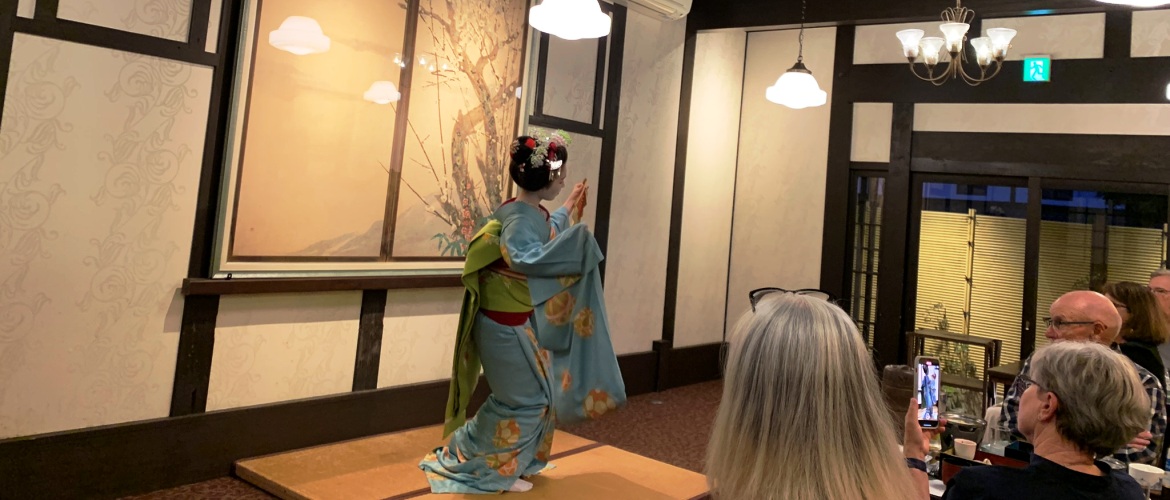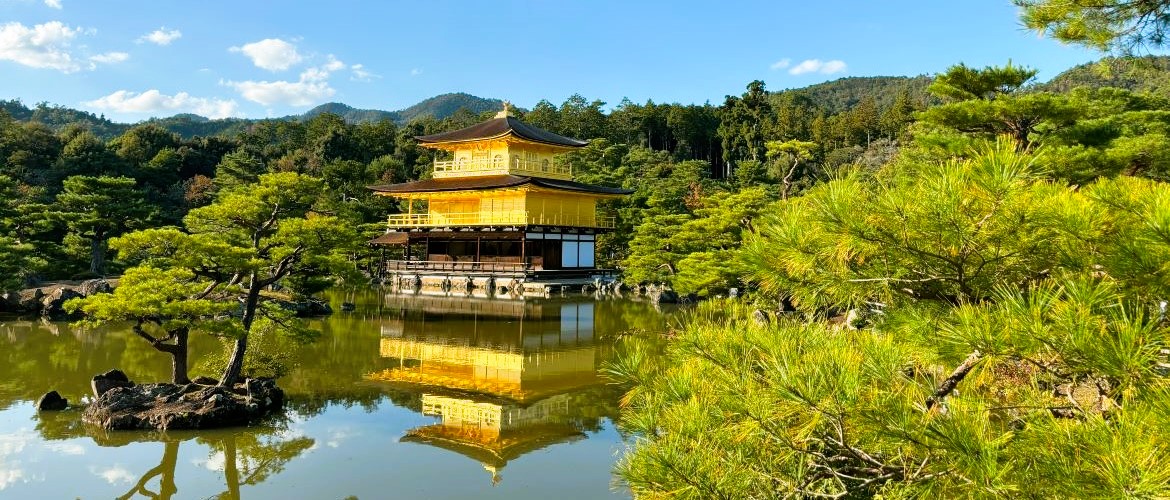
Tokyo – Kyoto – Nara – Osaka – Hiroshima – Miyajima – Tokyo
This meticulously curated itinerary takes you on a remarkable exploration of Japan’s iconic landmarks, serene landscapes, and ancient traditions. From the bustling streets of Osaka and Tokyo to the exquisite temples of Kyoto, each destination unfolds a unique chapter of Japan’s timeless charm.
Important Features
- Small group size – 20 maximum
- Experienced professional guides
- No shopping stops
- Quality Japanese & Western cuisines
- Kaiseki dinner with dancing geisha (maiko/(舞妓) performance
- Sukiyaki (hot pot) dinner featuring premium Japanese beef (wagyu)
Meal Code: B = breakfast / L = lunch / D = dinner
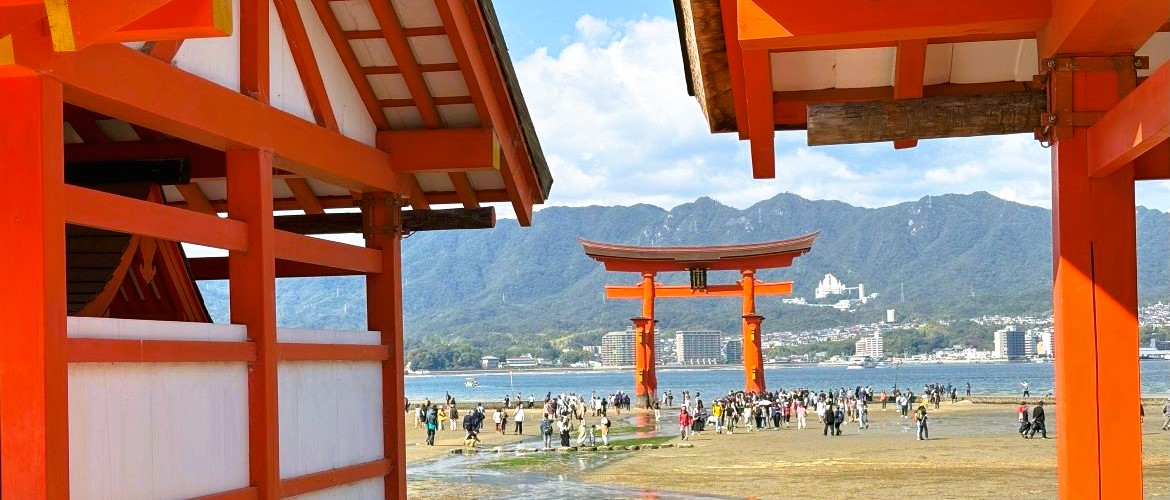
Day 1/Fri: Departing Home City
The journey begins with your transpacific flight departing from a city of your choice. You’ll lose a day upon crossing the International Date Line.
Day 2/Sat: Arrival in Tokyo
Welcome to Tokyo!
Please make your way to the hotel on your own. Detailed up-to-date information on how to get to the hotel will be provided in the pre-trip update two weeks before departure.
Private transfer can be arranged on request.
Day 3/Sun: Tokyo (B/L)
Tokyo, literally meaning “eastern capital” and officially named Tokyo Metropolis, is one of the most populous mega-cities in the world with a population of 14 million. Formerly known as Edo, the city has been the de facto seat of the Japanese government since 1603 when shogun Tokugawa Ieyasu chose the city for his headquarters. The shogun (general) was a hereditary commander ceremoniously appointed by the emperor but held real power over the country during the shogunate period between 1192 and 1867. Edo was renamed Tokyo after Emperor Meiji moved his seat from Kyoto in 1868 when the last shogun was forced to return power to the imperial court. The city covers an area of 2,187 square kilometres following the merger in 1943 of the city of Tokyo and Tokyo Prefecture.
Our full-day sightseeing begins at Senso-ji, the oldest Buddhist temple in Tokyo dating back to 628.
We then drive through ritzy Ginza shopping district to arrive at the plaza in front of the Imperial Palace (the palace itself is closed to tourists) for a stroll.
After lunch, we tour the grounds of the tranquil Meiji Jingu, a Shinto shrine dedicated to Emperor Meiji (1852 -1912) and his wife.
We end the day with a visit to the observation deck inside the Tokyo Metropolitan Government Building in Shinjuku. On a clear day, the visitor should be able to see Mount Fuji located 84km to the west.
Day 4/Mon: Tokyo – Kyoto (B/L)
This morning we ride the Shinkansen bullet train (Nozomi #65, 09:48/12:00) to Kyoto.
After lunch, we tour the historical Nijo Castle. This is the site that witnessed the commencement and ending of the Tokugawa shogunate (1600 -1868).
We then explore the famous Kinkaku-ji (Temple of Golden Pavilion). This is a Zen Buddhist temple and one of 17 locations comprising the Historic Monuments of Ancient Kyoto World Heritage Site.
Day 5/Tue: Kyoto (B/D)
Nicknamed “City of Ten Thousand Shrines”, Kyoto (literal translation: capital city) served as Japan’s capital for more than one thousand years before the imperial court moved to Tokyo in 1868 with the onset of the Meiji Restoration (1868 to 1912, a historical period associated with the emergence of Japan as a modernized nation). Kyoto is a scaled replica of the Chinese Tang Dynasty’s capital Chang’an, present-day Xi’an. The Tang Dynasty (618 – 907) was a golden era in Chinese history and a time when Japanese adoption of Chinese culture reached its peak. Kyoto today, with a population of 1.5 million, forms a major part of the Kyoto-Osaka-Kobe metropolitan area.
Morning sightseeing at Arashiyama (Storm Mountain) area takes in Tenryu-ji Temple and the Bamboo Forest. Located on the western outskirts of Kyoto, Arashiyama is famous for its immense natural beauty as well as its historical and cultural prominence due to the large number of well-preserved ancient Buddhist temples.
We spend the rest of the day touring the sprawling complex of Kiyomizu-dera and the famous geisha district, Gion, nearby.
Kiyomizu-dera is a Buddhist temple and part of the Historic Monuments of Ancient Kyoto UNESCO World Heritage site. Its veranda provides stunning views of the city.
Today’s traditional multi-course dinner (kaiseki) features performance by a maiko (geisha trainee).
Day 6/Wed: Kyoto – Nara – Osaka – Kyoto (B/L)
We depart for Nara at 08:00. The 45km drive to the magnificent Todai-ji temple takes about an hour. This ancient Buddhist temple is well-known not only for its splendid architecture and the huge bronze statue of the Buddha in the main hall but also for the 1,200 wild deer roaming freely on the grounds of the temple.
Nara is the capital city of Nara Prefecture and a former capital of Japan (710 – 794). With a population of roughly 370,000 and an area of 280 square kilometres, the city occupies the northern part of Nara Prefecture. Eight temples, shrines and ruins together with Kasugayama Primeval Forest collectively form “The Historic Monuments of Ancient Nara” – a UNESCO World Heritage Site.
Afterwards we continue on to Osaka, where we visit the historic Osaka Castle and Osaka’s legendary shopping and entertainment district known as Dotonbori. Situated at the mouth of the Yodo River on Osaka Bay, Osaka is Japan’s third most populous city (after Tokyo and Yokohama) and plays a significant role in Japanese economy. Osaka was once known as the “nation’s kitchen” because of its function as Japan’s rice trading centre during the Edo period.
We should be back at the hotel in Kyoto around 5:00 PM.
Day 7/Thu: Kyoto – Hiroshima (B)
Enjoy some well-deserved downtime this morning. Our rail journey to Hiroshima takes 1 hour 41 minutes (Nozomi #21, 11:46/13:27). Be sure to pack some snacks for lunch on the train.
After dropping off luggage at the hotel, we go on a leisurely outing to Miyajima Island. Officially known as Itsukushima, Miyajima is a small island (30 square kilometres, population 1,760) in Hiroshima Bay known for its forests and ancient temples. The seaside Itsukushima Shinto Shrine on the island is a UNESCO World Heritage Site and the “floating” torii gate in front of the shrine is the main reason for most visitors to come here.
The modes of transportation for the outing include local commuter train, ferry and taxi.
Day 8/Fri: Hiroshima – Tokyo (B/D)
Hiroshima, literally meaning ‘broad island’, is the capital of Hiroshima Prefecture and the largest city in the Chugoku region with a population of 1.2 million. Hiroshima is best known as the first city in history to be targeted by a nuclear weapon when the United States Army Air Forces dropped an atomic bomb on the city (and later on Nagasaki) at 8:15 a.m. on August 6, 1945, near the end of World War II. The highlight in Hiroshima, understandably but sadly, is the Peace Memorial Park which includes the Peace Memorial Museum, and the Atomic Bomb Dome that once served as the industrial promotion hall of the local prefect.
Morning sightseeing at the Peace Memorial Park complex includes 2 hours in the indoor museum onsite.
We return to Tokyo by bullet train (Nozomi #94, 12:03/15:57). Please pack some snacks for lunch on the train.
Farewell dinner is sukiyaki (hot pot) featuring premium Japanese beef (wagyu).
Day 9/Sat: Tokyo (B)
Free day to explore on your own.
We highly recommend Ginza and Akihabara shopping districts, which even non-shoppers would find exciting. Ginza’s central shopping boulevard is closed to vehicular traffic during busy shopping hours on weekends, making window shopping there a pleasant experience when the weather is nice.
Also recommended are the top-rated Tokyo National Museum and The National Museum of Western Art – both located at Ueno Park, one of Tokyo’s most popular locations for cherry blossom every spring. For guests interested in gardens, we also have a couple of good recommendations according to the season.
Be sure to carry your passport on you as merchandise purchase over 5,000 yen qualifies for sales tax-exemption at many stores and you must show your passport to claim it. If you are over 70 and want to enter Tokyo National Museum for free, you must present a valid ID (passport).
Day 10/Sun: Tokyo – Return Home (B)
The tour ends this morning. The Airport Limousine Bus is highly recommended for your transfer to the airport. The shuttle bus to Narita airport costs 3,200 yen (US$25), to Haneda 1,500 yen (US$14). Your guide and hotel concierge are both ready to assist you with your reservation.
Private transfer can be arranged on request.
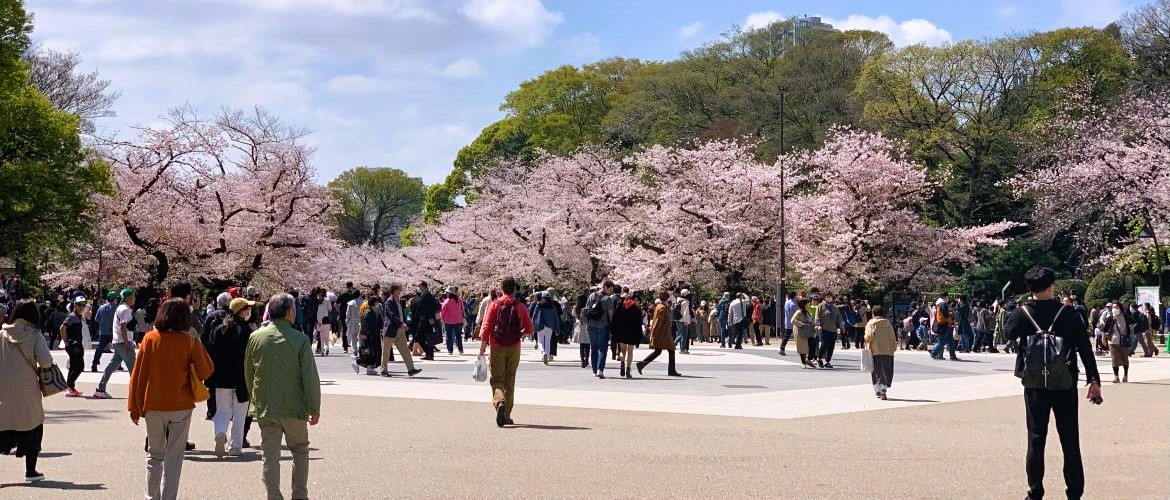
Hotel List
| City | Nights | Hotel | Category |
| Tokyo – first stay | 2 | Tokyo Dome Hotel or similar | first class |
| Kyoto | 3 | ANA Crowne Plaza Kyoto | first class |
| Hiroshima | 1 | ANA Crowne Plaza Hiroshima | first class |
| Tokyo – second stay | 2 | Tokyo Dome Hotel or similar | first class |
Hotels are subject to change without notice.
|
Dates & Prices
Save 10% on select departures. Contact us for details.
Prices are per person based on double occupancy | Limited spaces available
| Depart | Return | Land Only* | Single Supplement |
| (Fri) | (Sun) | CA$/US$ | CA$/US$ |
| 2024 | |||
| 05-Apr | 14-Apr | $6,345/$4,700 | $1,880/$1,390 |
| 10-May | 19-May | $6,345/$4,700 | $1,880/$1,390 |
| 18-Oct | 27-Oct | $6,345/$4,700 | $1,880/$1,390 |
| 01-Nov | 10-Nov | $6,345/$4,700 | $1,880/$1,390 |
| 2025 | |||
| 21-Mar | 30-Mar | $6,345/$4,700 | $1,880/$1,390 |
| 09-May | 18-May | $6,345/$4,700 | $1,880/$1,390 |
* Land Only price does not include international air. Contact us for a fare quote.
|
Tour price includes:
|
Tour price does NOT include:
See Terms & Conditions for more information. |
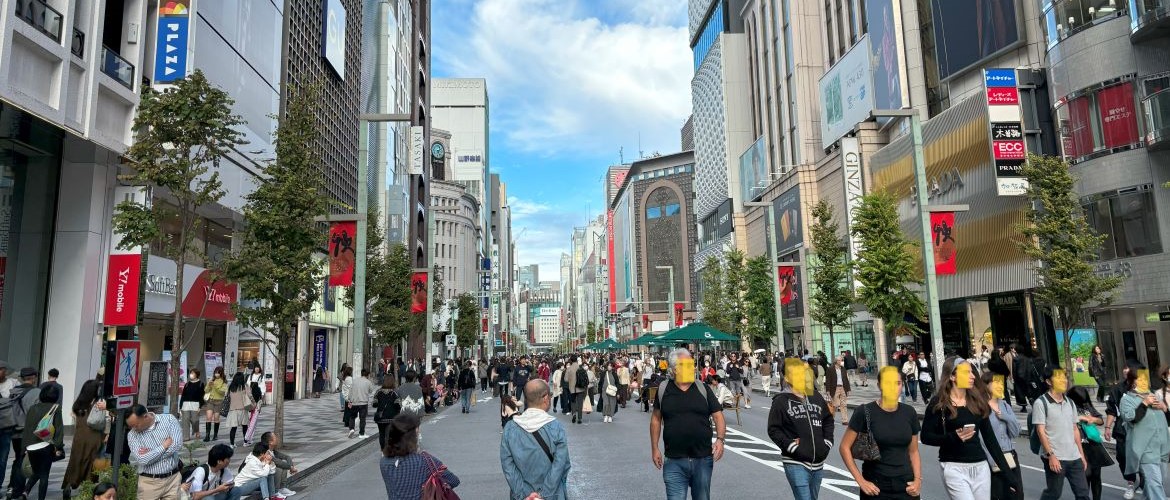
Passport & Visa
Your passport needs to have at least one blank visa page and six months validity at the end of the tour.
If you are a tourist from Canada, the US, the UK, Australia and New Zealand, you do not need a visa to enter Japan as long as your stay is within 90 days.
Immunization
Proof of vaccination against COVID-19 may be required. We will update you on this around your balance due date.
No certificate of any other inoculation is required. If necessary, check with your family doctor or a travel medicine clinic to determine what precautions you should take. We recommend vaccination against hepatitis A and suggest that you check out advice provided by the Health Canada and the US CDC.
Travel Health
Japan is a very clean country, where tap water is potable. Some may prefer to boil tap water to get rid of the possible smell of chlorine. Always carry a roll of toilet paper and a bottle of hand sanitizer. In general, public toilets in Japan do not provide paper towels for hand drying; many of them have no electric hand dryers either. You should carry a small towel as many Japanese do when going out. Footwear is often forbidden when you go indoors at temples, historical sites and traditional restaurants; please bring proper socks to keep your feet comfortable.
Local Currency & Credit Card
Japan: yen (JPY)
Withdrawing cash from local ATMs after arrival remains our recommended method of currency exchange. Keep your inventory of local currency low. Your tour fare already covers all the expensive items. You only need some cash for incidentals and meals not included in the tour price. Credit cards are widely accepted across Japan. For transactions over $50, you are advised to use a credit card.
Travel Insurance – When to Buy
Your deposit will be kept as credit if you cancel for any reason. The transferrable credit has no expiration date. Therefore, it may be unnecessary to spend $30 to $50 on cancellation insurance just to protect the deposit.
However, purchase of trip cancellation & emergency medical insurance is strongly advised when your balance is due. If you don’t have proper coverage, the loss can be devastating in case of cancellation before or after commencement of the booked trip or in case of a serious medical emergency during the trip. Please ask us premium quotes when your balance due date is near.
